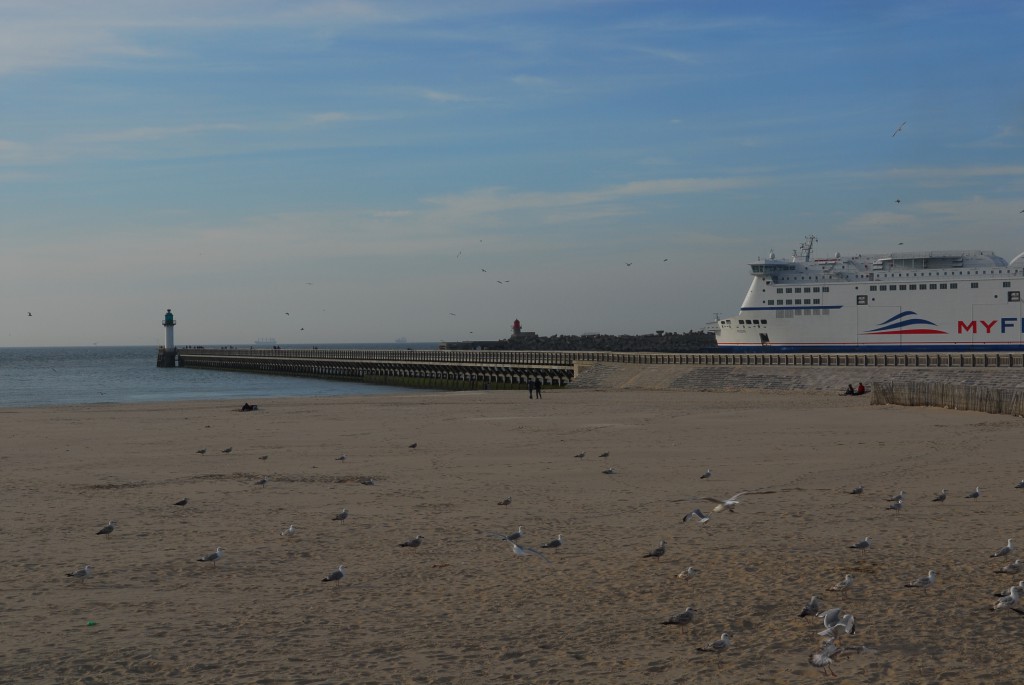“Yemanja, Yemanja ijfndkv ndösh nfehi”
Die freundliche, klare und sehr sympathische Stimme einer jungen Frau tönt genau zu dem Zeitpunkt aus dem Funkgerät, als ich mich frage, was denn die kleinen Flämmchen auf der Karte im Plotter bedeuten könnten. Auf der gedruckten Version habe ich sie nämlich gänzlich übersehen!
“This is Yemanja, sorry I do not understand!”
“Yemanja, this is shooting range. What is your destination?”
“My destination is Calais!”
” We are shooting for four miles today. Can you change your course?”
“What course do you recommend?”
“300 degrees.”
“Okay, we go to 300 degrees.”
“Thanks for your cooperation. We will call you when you can go back on your course.”
Mit anderen Worte: Vor Nieuwport spielen die Belgier Krieg und wir müssen circa drei Meilen von unserem Kurs abweichen. Für die, die unseren Kurs verfolgen – daher die Ecke!
Im Ärmelkanal wird nicht nur scharf geschossen. Er ist voller Fähren, Containerschiffen, Bojen aller Art, Wracks,Windparks, Bohrinseln. Auf den Sandbänken vor Calais sind Fischfarmen oder Angler mit ihren kleinen Motorbötchen. Eine dieser Sandbänke ist für den Umweg vor Calais verantwortlich. Langweilig wird es draußen jedenfalls nie, weil es immer irgendetwas zu beobachten oder beachten gibt.
Calais ist eine blühende Stadt – im Gegensatz zu Oostende, trotz ähnlicher Ausgangsumstände. Überall sind Blumen! Die Franzosen verstehen etwas davon, sommerliche Blumenbeete und Gartenanlagen anzulegen. Die schönen alten Häuser sind auch hier den Bomben zum Opfer gefallen, doch sind die Neubauten – nicht schön, aber zumindest nicht grauenhaft. Calais ist immer noch ein sehr lebendiger Fährhafen: Etwa alle 20 Minuten kommt oder geht eine Fähre nach England, 30 Millionen Menschen und 1,7 Millionen LKWs queren hier jährlich den Ärmelkanal.
Ein wenig nervös war ich vor der Einfahrt schon: Mein Französisch ist doch schon sehr eingerostet! Wie sollte ich mit der Port Control kommunizieren? Doch auch hier wird Englisch gesprochen, ja es war mir eine besondere Freude zu hören, dass selbst die Franzosen hier Englisch miteinander reden, damit alle zuhörenden Schiffe, auch die Segler, wissen, wer wann wo anlegt oder ablegt.
Wir kamen pünktlich zum Öffnen der Brücke zur Marina, wurden von zwei Hafenmeistern in Empfang genommen, meldeten uns ordnungsgemäß an – auch hier ist Frankreich etwas anders gestrickt als Belgien, wo sich kein Mensch um dieses Schild kümmert:
Freitag abends fahren die Menschen hier zum Quai, suchen sich einen Parkplatz mit Aussicht aufs Meer. Familien mit Kindern, junge Liebespaare, Damen gesetzten Alters, mit Hund oder Katze, alle sitzen sie im Auto und essen Eis, belegtes Baguette oder so etwas wie Krapfen aus der Friterie de la Nation, dem Büdchen am Strand. Sie halten ihren Kaffeeklatsch, streiten und küssen sich – ein Hauch von Leichtigkeit, von Savoir Vivre , schwebt über allen. Bienvenue a France!
“Yemanja, Yemanja ijfndkv ndösh nfehi”
The friendly, clear and very nice voice of a young woman comes from the VHF. I’ve just been asking myself why there are little red flames in the chart and what they could possibly mean.
“This is Yemanja, sorry I do not understand!”
“Yemanja, this is shooting range. What is your destination?”
“My destination is Calais!”
” We are shooting for four miles today. Can you change your course?”
“What course do you recommend?”
“300 degrees.”
“Okay, we go to 300 degrees.”
“Thanks for your cooperation. We will call you when you can go back on your course.”
In other words: In front of Nieuwport the Belgians still play war. And this was the reason for that first hook in our track.
There’s not only shooting in the Channel, but lots of ferries, container vessels, wind parks, oil drilling, wrecks, bouys of any kind. On the banks in front of Calais there are fish farms and small fishing boats. Due to one of these banks we had to do that little detour before entering Calais. Anyway it’s never boring out there, as there is always something to watch and to obey.
Calais is a thriving little town, in opposite to Oostende despite similar circumstances. There arhorriblee flowers everywhere. The French really know about gardening and summer bedding. The beautiful old houses were bombed down as well, but the new ones are – well, not pretty, but at least not horrible. Calais still is a very thriving ferry terminal: Ferries leave and come in aprox. every 20 minutes. 30 million people and 1,7 lorries pass through here yearly.
I was a bit nervous about entering the port: I lost most of my French – so how should I talk to port control? But they speak English here as well. Actually it was a special pleasure to listen to the French talking English to each other, so that all the sail ships understand as well what is going on in the port.
We arrived just in time for the opening of the bridge to the marina. We were welcomed by two harbor masters and had to register immediately with our papers. Quite different to Belgium where nobody cared about the Schengen sign!
Friday evenings people here drive to the quay and park with a good view of the sea. Families with kids, young lovers, elderly ladies, with dogs or cats, all are sitting in the car and eat ice cream, baguette or fried stuff from the Friterie de la Mer. They talk, fight or kiss, there is a flair of easiness in the air, of Savoir Vivre. Bienvenue a France![codepeople-post-map]
